Analysis of Leadership and Operational Management at M&S
VerifiedAdded on 2020/01/16
|12
|4192
|244
Report
AI Summary
This report provides a comprehensive analysis of leadership and management practices within M&S Limited, a prominent clothing manufacturer. It begins by differentiating between the roles of leaders and managers, highlighting their respective responsibilities in achieving organizational goals. The report then delves into the characteristics of effective leaders and managers, emphasizing their importance in maintaining smooth operations and fostering innovation. A significant portion of the report focuses on the practical application of leadership theories, such as situational leadership, system leadership, and contingency theory, within the context of M&S. It also explores key approaches to operational management, including the Just-in-Time approach, and the roles of leaders and managers in maintaining a balance between demand and supply, ensuring customer satisfaction, and resolving conflicts. The report emphasizes the importance of market analysis, customer satisfaction, and conflict resolution in achieving sustainable business objectives within M&S. The analysis includes discussion of how these roles are implemented in the context of M&S's global operations, with the aim of improving productivity and sustainability.
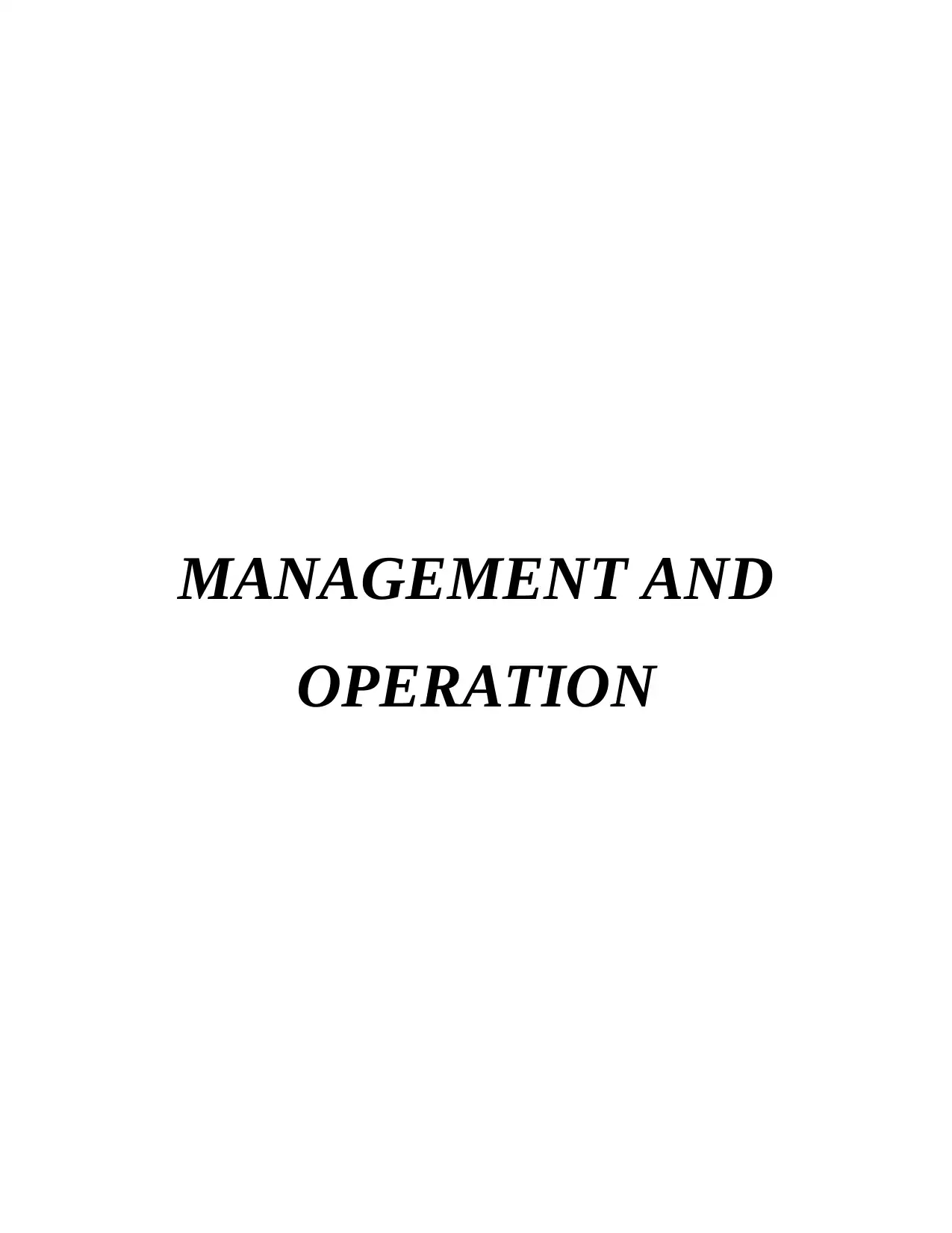
MANAGEMENT AND
OPERATION
OPERATION
Paraphrase This Document
Need a fresh take? Get an instant paraphrase of this document with our AI Paraphraser
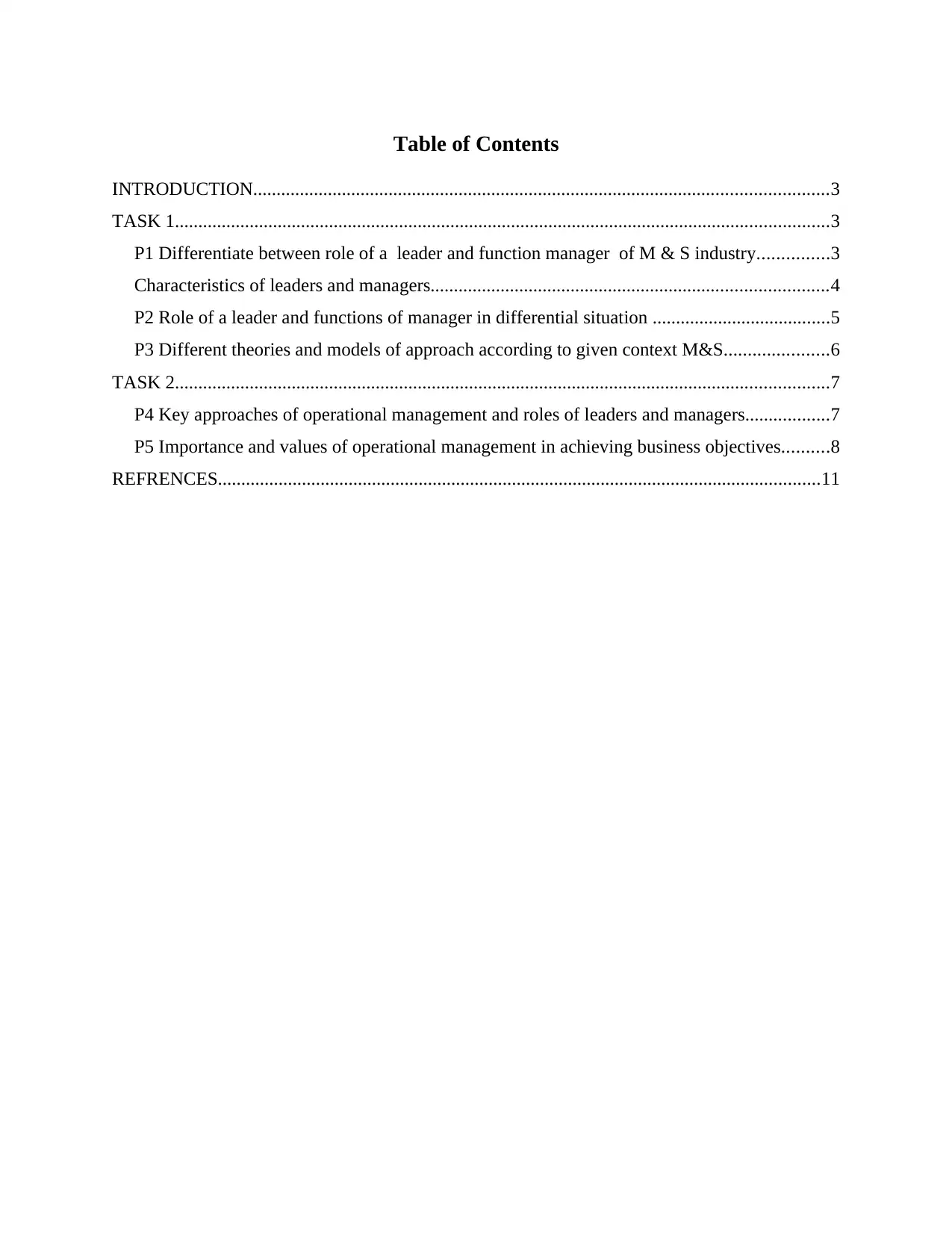
Table of Contents
INTRODUCTION...........................................................................................................................3
TASK 1............................................................................................................................................3
P1 Differentiate between role of a leader and function manager of M & S industry...............3
Characteristics of leaders and managers.....................................................................................4
P2 Role of a leader and functions of manager in differential situation ......................................5
P3 Different theories and models of approach according to given context M&S......................6
TASK 2............................................................................................................................................7
P4 Key approaches of operational management and roles of leaders and managers..................7
P5 Importance and values of operational management in achieving business objectives..........8
REFRENCES.................................................................................................................................11
INTRODUCTION...........................................................................................................................3
TASK 1............................................................................................................................................3
P1 Differentiate between role of a leader and function manager of M & S industry...............3
Characteristics of leaders and managers.....................................................................................4
P2 Role of a leader and functions of manager in differential situation ......................................5
P3 Different theories and models of approach according to given context M&S......................6
TASK 2............................................................................................................................................7
P4 Key approaches of operational management and roles of leaders and managers..................7
P5 Importance and values of operational management in achieving business objectives..........8
REFRENCES.................................................................................................................................11
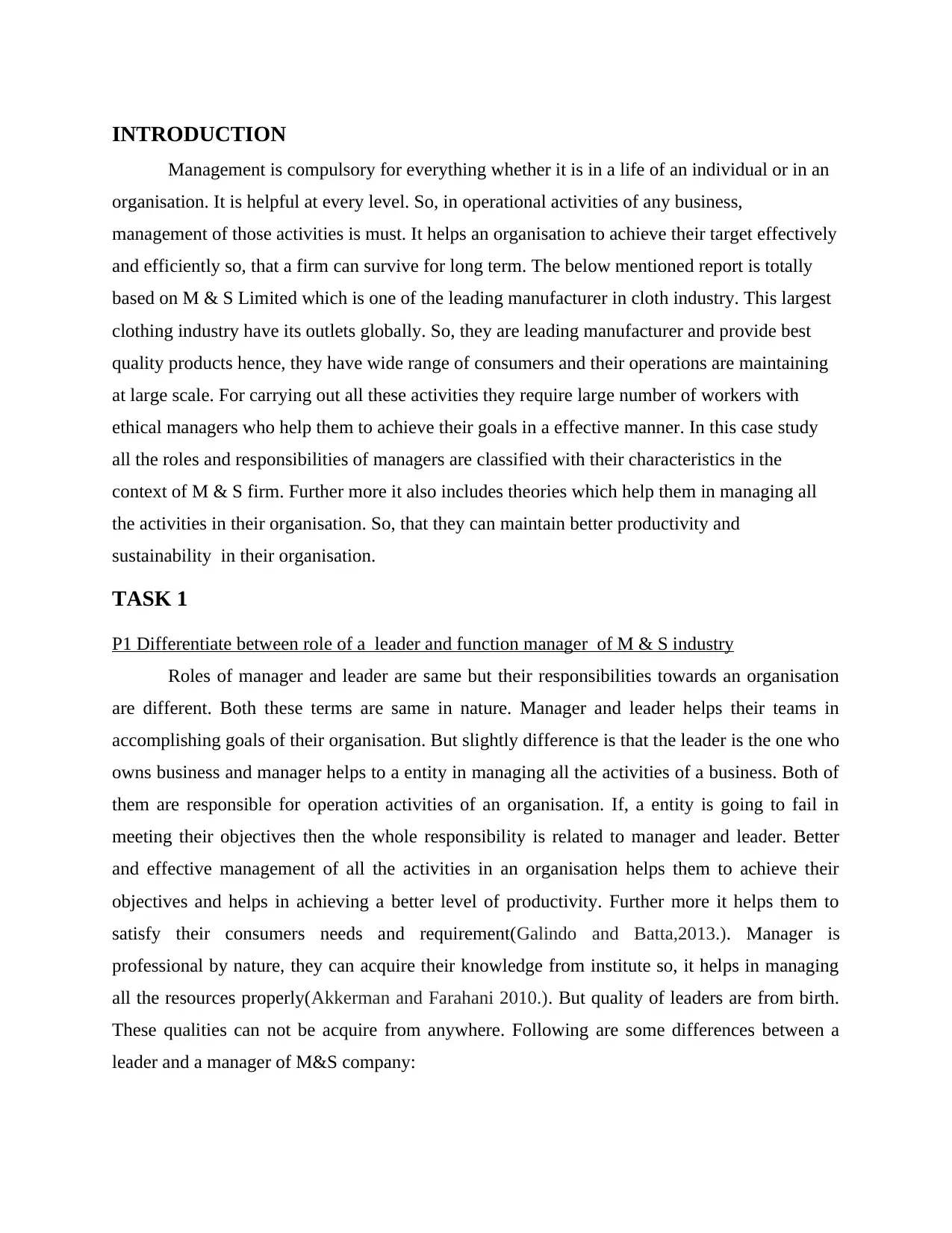
INTRODUCTION
Management is compulsory for everything whether it is in a life of an individual or in an
organisation. It is helpful at every level. So, in operational activities of any business,
management of those activities is must. It helps an organisation to achieve their target effectively
and efficiently so, that a firm can survive for long term. The below mentioned report is totally
based on M & S Limited which is one of the leading manufacturer in cloth industry. This largest
clothing industry have its outlets globally. So, they are leading manufacturer and provide best
quality products hence, they have wide range of consumers and their operations are maintaining
at large scale. For carrying out all these activities they require large number of workers with
ethical managers who help them to achieve their goals in a effective manner. In this case study
all the roles and responsibilities of managers are classified with their characteristics in the
context of M & S firm. Further more it also includes theories which help them in managing all
the activities in their organisation. So, that they can maintain better productivity and
sustainability in their organisation.
TASK 1
P1 Differentiate between role of a leader and function manager of M & S industry
Roles of manager and leader are same but their responsibilities towards an organisation
are different. Both these terms are same in nature. Manager and leader helps their teams in
accomplishing goals of their organisation. But slightly difference is that the leader is the one who
owns business and manager helps to a entity in managing all the activities of a business. Both of
them are responsible for operation activities of an organisation. If, a entity is going to fail in
meeting their objectives then the whole responsibility is related to manager and leader. Better
and effective management of all the activities in an organisation helps them to achieve their
objectives and helps in achieving a better level of productivity. Further more it helps them to
satisfy their consumers needs and requirement(Galindo and Batta,2013.). Manager is
professional by nature, they can acquire their knowledge from institute so, it helps in managing
all the resources properly(Akkerman and Farahani 2010.). But quality of leaders are from birth.
These qualities can not be acquire from anywhere. Following are some differences between a
leader and a manager of M&S company:
Management is compulsory for everything whether it is in a life of an individual or in an
organisation. It is helpful at every level. So, in operational activities of any business,
management of those activities is must. It helps an organisation to achieve their target effectively
and efficiently so, that a firm can survive for long term. The below mentioned report is totally
based on M & S Limited which is one of the leading manufacturer in cloth industry. This largest
clothing industry have its outlets globally. So, they are leading manufacturer and provide best
quality products hence, they have wide range of consumers and their operations are maintaining
at large scale. For carrying out all these activities they require large number of workers with
ethical managers who help them to achieve their goals in a effective manner. In this case study
all the roles and responsibilities of managers are classified with their characteristics in the
context of M & S firm. Further more it also includes theories which help them in managing all
the activities in their organisation. So, that they can maintain better productivity and
sustainability in their organisation.
TASK 1
P1 Differentiate between role of a leader and function manager of M & S industry
Roles of manager and leader are same but their responsibilities towards an organisation
are different. Both these terms are same in nature. Manager and leader helps their teams in
accomplishing goals of their organisation. But slightly difference is that the leader is the one who
owns business and manager helps to a entity in managing all the activities of a business. Both of
them are responsible for operation activities of an organisation. If, a entity is going to fail in
meeting their objectives then the whole responsibility is related to manager and leader. Better
and effective management of all the activities in an organisation helps them to achieve their
objectives and helps in achieving a better level of productivity. Further more it helps them to
satisfy their consumers needs and requirement(Galindo and Batta,2013.). Manager is
professional by nature, they can acquire their knowledge from institute so, it helps in managing
all the resources properly(Akkerman and Farahani 2010.). But quality of leaders are from birth.
These qualities can not be acquire from anywhere. Following are some differences between a
leader and a manager of M&S company:
⊘ This is a preview!⊘
Do you want full access?
Subscribe today to unlock all pages.

Trusted by 1+ million students worldwide
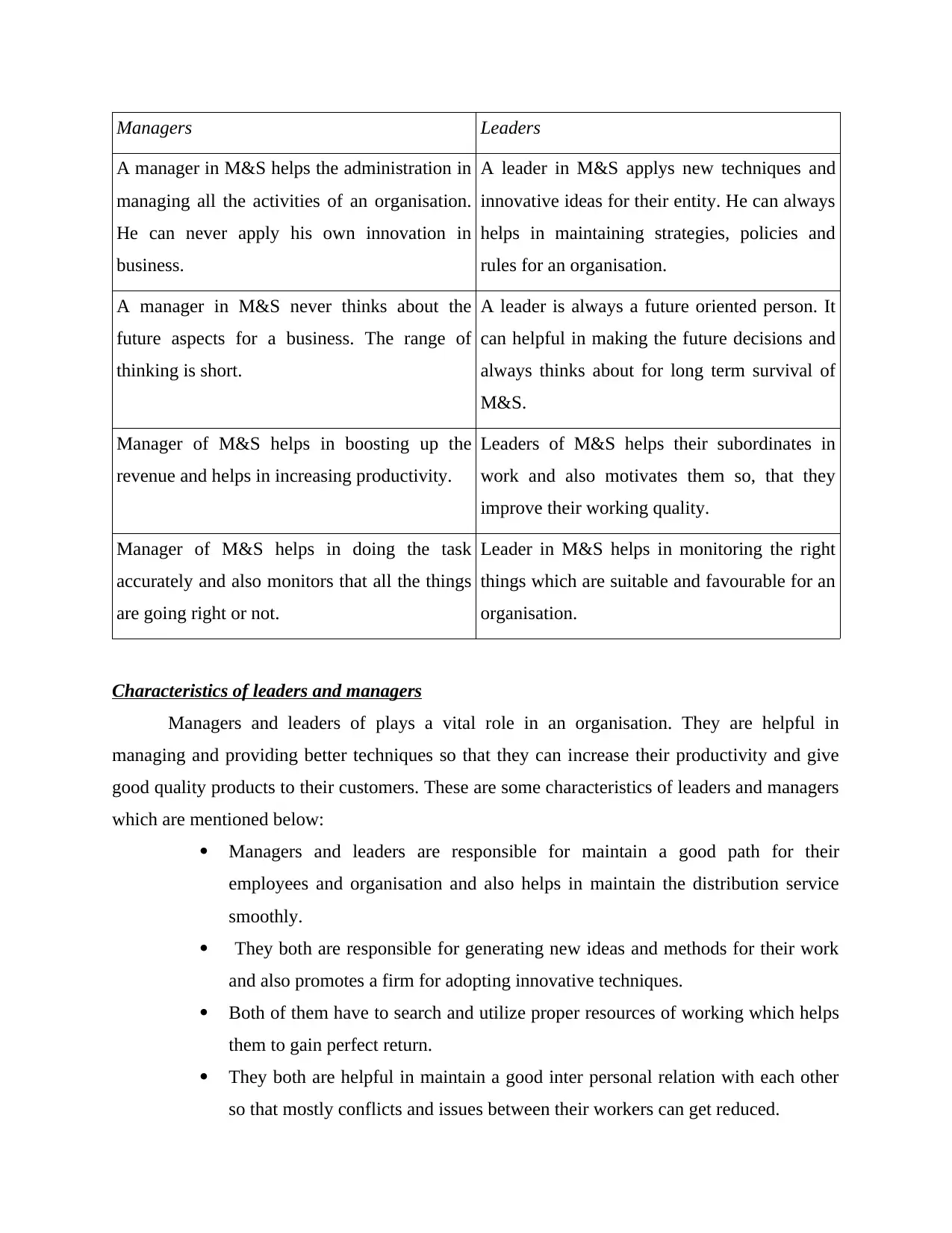
Managers Leaders
A manager in M&S helps the administration in
managing all the activities of an organisation.
He can never apply his own innovation in
business.
A leader in M&S applys new techniques and
innovative ideas for their entity. He can always
helps in maintaining strategies, policies and
rules for an organisation.
A manager in M&S never thinks about the
future aspects for a business. The range of
thinking is short.
A leader is always a future oriented person. It
can helpful in making the future decisions and
always thinks about for long term survival of
M&S.
Manager of M&S helps in boosting up the
revenue and helps in increasing productivity.
Leaders of M&S helps their subordinates in
work and also motivates them so, that they
improve their working quality.
Manager of M&S helps in doing the task
accurately and also monitors that all the things
are going right or not.
Leader in M&S helps in monitoring the right
things which are suitable and favourable for an
organisation.
Characteristics of leaders and managers
Managers and leaders of plays a vital role in an organisation. They are helpful in
managing and providing better techniques so that they can increase their productivity and give
good quality products to their customers. These are some characteristics of leaders and managers
which are mentioned below:
Managers and leaders are responsible for maintain a good path for their
employees and organisation and also helps in maintain the distribution service
smoothly.
They both are responsible for generating new ideas and methods for their work
and also promotes a firm for adopting innovative techniques.
Both of them have to search and utilize proper resources of working which helps
them to gain perfect return.
They both are helpful in maintain a good inter personal relation with each other
so that mostly conflicts and issues between their workers can get reduced.
A manager in M&S helps the administration in
managing all the activities of an organisation.
He can never apply his own innovation in
business.
A leader in M&S applys new techniques and
innovative ideas for their entity. He can always
helps in maintaining strategies, policies and
rules for an organisation.
A manager in M&S never thinks about the
future aspects for a business. The range of
thinking is short.
A leader is always a future oriented person. It
can helpful in making the future decisions and
always thinks about for long term survival of
M&S.
Manager of M&S helps in boosting up the
revenue and helps in increasing productivity.
Leaders of M&S helps their subordinates in
work and also motivates them so, that they
improve their working quality.
Manager of M&S helps in doing the task
accurately and also monitors that all the things
are going right or not.
Leader in M&S helps in monitoring the right
things which are suitable and favourable for an
organisation.
Characteristics of leaders and managers
Managers and leaders of plays a vital role in an organisation. They are helpful in
managing and providing better techniques so that they can increase their productivity and give
good quality products to their customers. These are some characteristics of leaders and managers
which are mentioned below:
Managers and leaders are responsible for maintain a good path for their
employees and organisation and also helps in maintain the distribution service
smoothly.
They both are responsible for generating new ideas and methods for their work
and also promotes a firm for adopting innovative techniques.
Both of them have to search and utilize proper resources of working which helps
them to gain perfect return.
They both are helpful in maintain a good inter personal relation with each other
so that mostly conflicts and issues between their workers can get reduced.
Paraphrase This Document
Need a fresh take? Get an instant paraphrase of this document with our AI Paraphraser
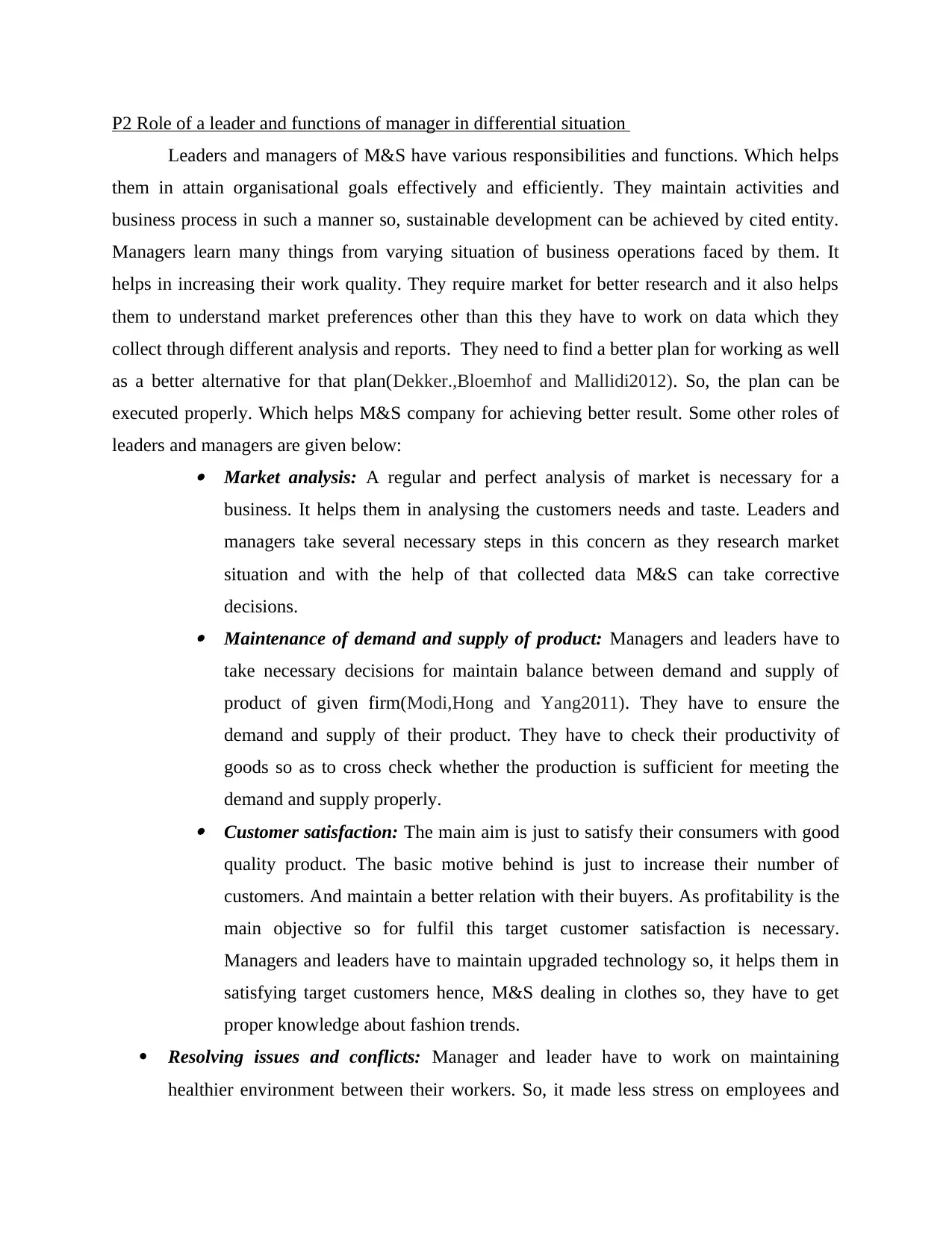
P2 Role of a leader and functions of manager in differential situation
Leaders and managers of M&S have various responsibilities and functions. Which helps
them in attain organisational goals effectively and efficiently. They maintain activities and
business process in such a manner so, sustainable development can be achieved by cited entity.
Managers learn many things from varying situation of business operations faced by them. It
helps in increasing their work quality. They require market for better research and it also helps
them to understand market preferences other than this they have to work on data which they
collect through different analysis and reports. They need to find a better plan for working as well
as a better alternative for that plan(Dekker.,Bloemhof and Mallidi2012). So, the plan can be
executed properly. Which helps M&S company for achieving better result. Some other roles of
leaders and managers are given below:
Market analysis: A regular and perfect analysis of market is necessary for a
business. It helps them in analysing the customers needs and taste. Leaders and
managers take several necessary steps in this concern as they research market
situation and with the help of that collected data M&S can take corrective
decisions.
Maintenance of demand and supply of product: Managers and leaders have to
take necessary decisions for maintain balance between demand and supply of
product of given firm(Modi,Hong and Yang2011). They have to ensure the
demand and supply of their product. They have to check their productivity of
goods so as to cross check whether the production is sufficient for meeting the
demand and supply properly.
Customer satisfaction: The main aim is just to satisfy their consumers with good
quality product. The basic motive behind is just to increase their number of
customers. And maintain a better relation with their buyers. As profitability is the
main objective so for fulfil this target customer satisfaction is necessary.
Managers and leaders have to maintain upgraded technology so, it helps them in
satisfying target customers hence, M&S dealing in clothes so, they have to get
proper knowledge about fashion trends.
Resolving issues and conflicts: Manager and leader have to work on maintaining
healthier environment between their workers. So, it made less stress on employees and
Leaders and managers of M&S have various responsibilities and functions. Which helps
them in attain organisational goals effectively and efficiently. They maintain activities and
business process in such a manner so, sustainable development can be achieved by cited entity.
Managers learn many things from varying situation of business operations faced by them. It
helps in increasing their work quality. They require market for better research and it also helps
them to understand market preferences other than this they have to work on data which they
collect through different analysis and reports. They need to find a better plan for working as well
as a better alternative for that plan(Dekker.,Bloemhof and Mallidi2012). So, the plan can be
executed properly. Which helps M&S company for achieving better result. Some other roles of
leaders and managers are given below:
Market analysis: A regular and perfect analysis of market is necessary for a
business. It helps them in analysing the customers needs and taste. Leaders and
managers take several necessary steps in this concern as they research market
situation and with the help of that collected data M&S can take corrective
decisions.
Maintenance of demand and supply of product: Managers and leaders have to
take necessary decisions for maintain balance between demand and supply of
product of given firm(Modi,Hong and Yang2011). They have to ensure the
demand and supply of their product. They have to check their productivity of
goods so as to cross check whether the production is sufficient for meeting the
demand and supply properly.
Customer satisfaction: The main aim is just to satisfy their consumers with good
quality product. The basic motive behind is just to increase their number of
customers. And maintain a better relation with their buyers. As profitability is the
main objective so for fulfil this target customer satisfaction is necessary.
Managers and leaders have to maintain upgraded technology so, it helps them in
satisfying target customers hence, M&S dealing in clothes so, they have to get
proper knowledge about fashion trends.
Resolving issues and conflicts: Manager and leader have to work on maintaining
healthier environment between their workers. So, it made less stress on employees and
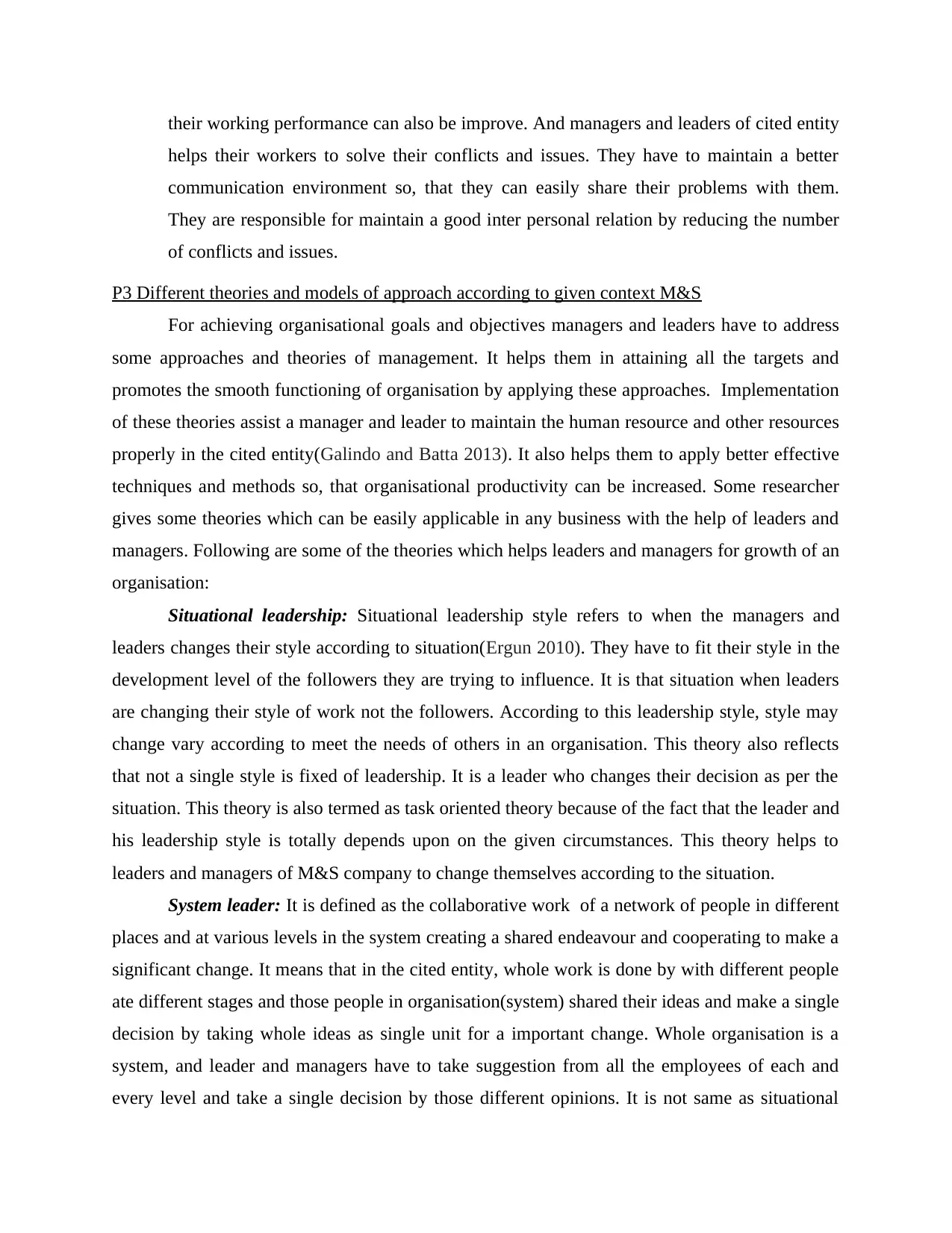
their working performance can also be improve. And managers and leaders of cited entity
helps their workers to solve their conflicts and issues. They have to maintain a better
communication environment so, that they can easily share their problems with them.
They are responsible for maintain a good inter personal relation by reducing the number
of conflicts and issues.
P3 Different theories and models of approach according to given context M&S
For achieving organisational goals and objectives managers and leaders have to address
some approaches and theories of management. It helps them in attaining all the targets and
promotes the smooth functioning of organisation by applying these approaches. Implementation
of these theories assist a manager and leader to maintain the human resource and other resources
properly in the cited entity(Galindo and Batta 2013). It also helps them to apply better effective
techniques and methods so, that organisational productivity can be increased. Some researcher
gives some theories which can be easily applicable in any business with the help of leaders and
managers. Following are some of the theories which helps leaders and managers for growth of an
organisation:
Situational leadership: Situational leadership style refers to when the managers and
leaders changes their style according to situation(Ergun 2010). They have to fit their style in the
development level of the followers they are trying to influence. It is that situation when leaders
are changing their style of work not the followers. According to this leadership style, style may
change vary according to meet the needs of others in an organisation. This theory also reflects
that not a single style is fixed of leadership. It is a leader who changes their decision as per the
situation. This theory is also termed as task oriented theory because of the fact that the leader and
his leadership style is totally depends upon on the given circumstances. This theory helps to
leaders and managers of M&S company to change themselves according to the situation.
System leader: It is defined as the collaborative work of a network of people in different
places and at various levels in the system creating a shared endeavour and cooperating to make a
significant change. It means that in the cited entity, whole work is done by with different people
ate different stages and those people in organisation(system) shared their ideas and make a single
decision by taking whole ideas as single unit for a important change. Whole organisation is a
system, and leader and managers have to take suggestion from all the employees of each and
every level and take a single decision by those different opinions. It is not same as situational
helps their workers to solve their conflicts and issues. They have to maintain a better
communication environment so, that they can easily share their problems with them.
They are responsible for maintain a good inter personal relation by reducing the number
of conflicts and issues.
P3 Different theories and models of approach according to given context M&S
For achieving organisational goals and objectives managers and leaders have to address
some approaches and theories of management. It helps them in attaining all the targets and
promotes the smooth functioning of organisation by applying these approaches. Implementation
of these theories assist a manager and leader to maintain the human resource and other resources
properly in the cited entity(Galindo and Batta 2013). It also helps them to apply better effective
techniques and methods so, that organisational productivity can be increased. Some researcher
gives some theories which can be easily applicable in any business with the help of leaders and
managers. Following are some of the theories which helps leaders and managers for growth of an
organisation:
Situational leadership: Situational leadership style refers to when the managers and
leaders changes their style according to situation(Ergun 2010). They have to fit their style in the
development level of the followers they are trying to influence. It is that situation when leaders
are changing their style of work not the followers. According to this leadership style, style may
change vary according to meet the needs of others in an organisation. This theory also reflects
that not a single style is fixed of leadership. It is a leader who changes their decision as per the
situation. This theory is also termed as task oriented theory because of the fact that the leader and
his leadership style is totally depends upon on the given circumstances. This theory helps to
leaders and managers of M&S company to change themselves according to the situation.
System leader: It is defined as the collaborative work of a network of people in different
places and at various levels in the system creating a shared endeavour and cooperating to make a
significant change. It means that in the cited entity, whole work is done by with different people
ate different stages and those people in organisation(system) shared their ideas and make a single
decision by taking whole ideas as single unit for a important change. Whole organisation is a
system, and leader and managers have to take suggestion from all the employees of each and
every level and take a single decision by those different opinions. It is not same as situational
⊘ This is a preview!⊘
Do you want full access?
Subscribe today to unlock all pages.

Trusted by 1+ million students worldwide
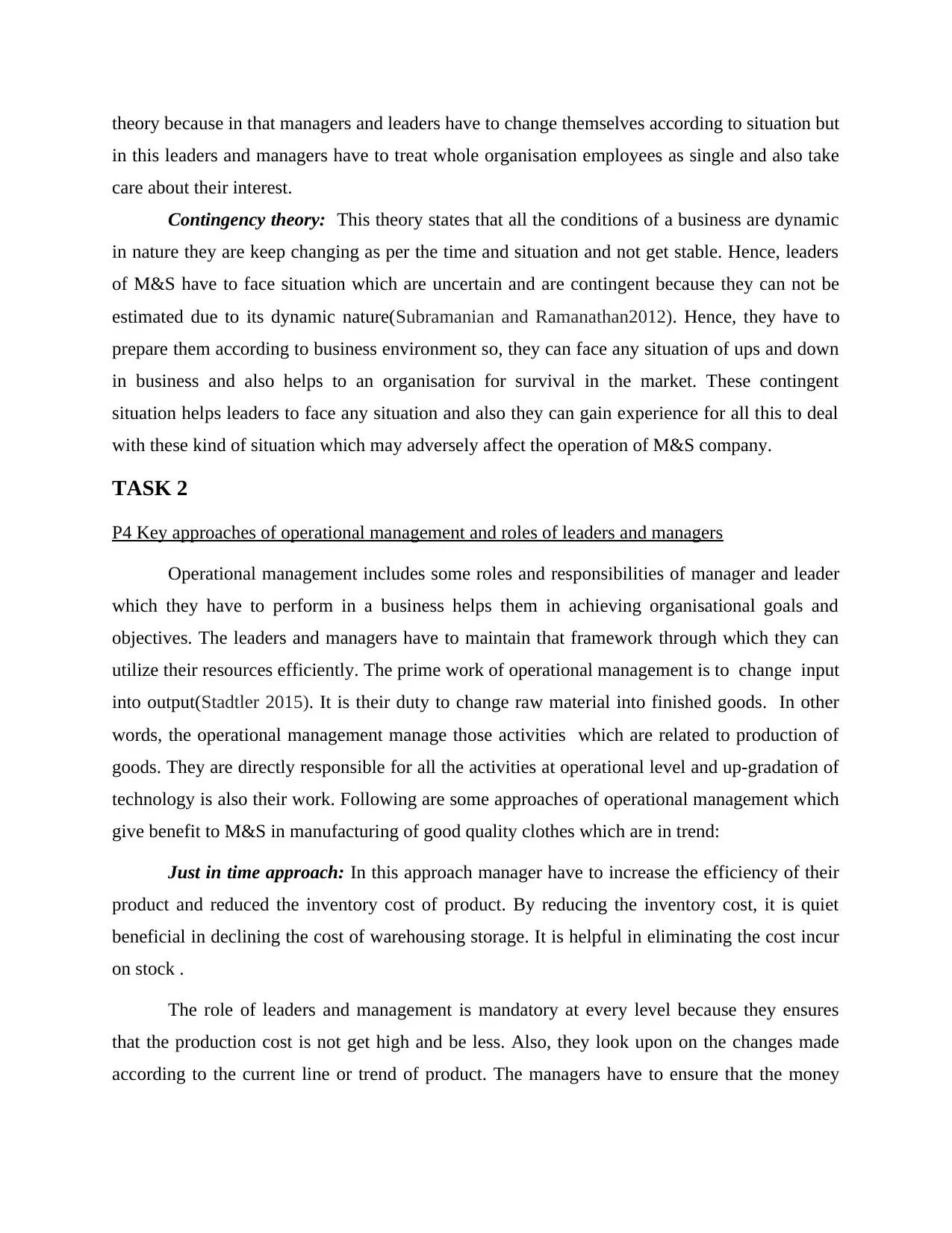
theory because in that managers and leaders have to change themselves according to situation but
in this leaders and managers have to treat whole organisation employees as single and also take
care about their interest.
Contingency theory: This theory states that all the conditions of a business are dynamic
in nature they are keep changing as per the time and situation and not get stable. Hence, leaders
of M&S have to face situation which are uncertain and are contingent because they can not be
estimated due to its dynamic nature(Subramanian and Ramanathan2012). Hence, they have to
prepare them according to business environment so, they can face any situation of ups and down
in business and also helps to an organisation for survival in the market. These contingent
situation helps leaders to face any situation and also they can gain experience for all this to deal
with these kind of situation which may adversely affect the operation of M&S company.
TASK 2
P4 Key approaches of operational management and roles of leaders and managers
Operational management includes some roles and responsibilities of manager and leader
which they have to perform in a business helps them in achieving organisational goals and
objectives. The leaders and managers have to maintain that framework through which they can
utilize their resources efficiently. The prime work of operational management is to change input
into output(Stadtler 2015). It is their duty to change raw material into finished goods. In other
words, the operational management manage those activities which are related to production of
goods. They are directly responsible for all the activities at operational level and up-gradation of
technology is also their work. Following are some approaches of operational management which
give benefit to M&S in manufacturing of good quality clothes which are in trend:
Just in time approach: In this approach manager have to increase the efficiency of their
product and reduced the inventory cost of product. By reducing the inventory cost, it is quiet
beneficial in declining the cost of warehousing storage. It is helpful in eliminating the cost incur
on stock .
The role of leaders and management is mandatory at every level because they ensures
that the production cost is not get high and be less. Also, they look upon on the changes made
according to the current line or trend of product. The managers have to ensure that the money
in this leaders and managers have to treat whole organisation employees as single and also take
care about their interest.
Contingency theory: This theory states that all the conditions of a business are dynamic
in nature they are keep changing as per the time and situation and not get stable. Hence, leaders
of M&S have to face situation which are uncertain and are contingent because they can not be
estimated due to its dynamic nature(Subramanian and Ramanathan2012). Hence, they have to
prepare them according to business environment so, they can face any situation of ups and down
in business and also helps to an organisation for survival in the market. These contingent
situation helps leaders to face any situation and also they can gain experience for all this to deal
with these kind of situation which may adversely affect the operation of M&S company.
TASK 2
P4 Key approaches of operational management and roles of leaders and managers
Operational management includes some roles and responsibilities of manager and leader
which they have to perform in a business helps them in achieving organisational goals and
objectives. The leaders and managers have to maintain that framework through which they can
utilize their resources efficiently. The prime work of operational management is to change input
into output(Stadtler 2015). It is their duty to change raw material into finished goods. In other
words, the operational management manage those activities which are related to production of
goods. They are directly responsible for all the activities at operational level and up-gradation of
technology is also their work. Following are some approaches of operational management which
give benefit to M&S in manufacturing of good quality clothes which are in trend:
Just in time approach: In this approach manager have to increase the efficiency of their
product and reduced the inventory cost of product. By reducing the inventory cost, it is quiet
beneficial in declining the cost of warehousing storage. It is helpful in eliminating the cost incur
on stock .
The role of leaders and management is mandatory at every level because they ensures
that the production cost is not get high and be less. Also, they look upon on the changes made
according to the current line or trend of product. The managers have to ensure that the money
Paraphrase This Document
Need a fresh take? Get an instant paraphrase of this document with our AI Paraphraser
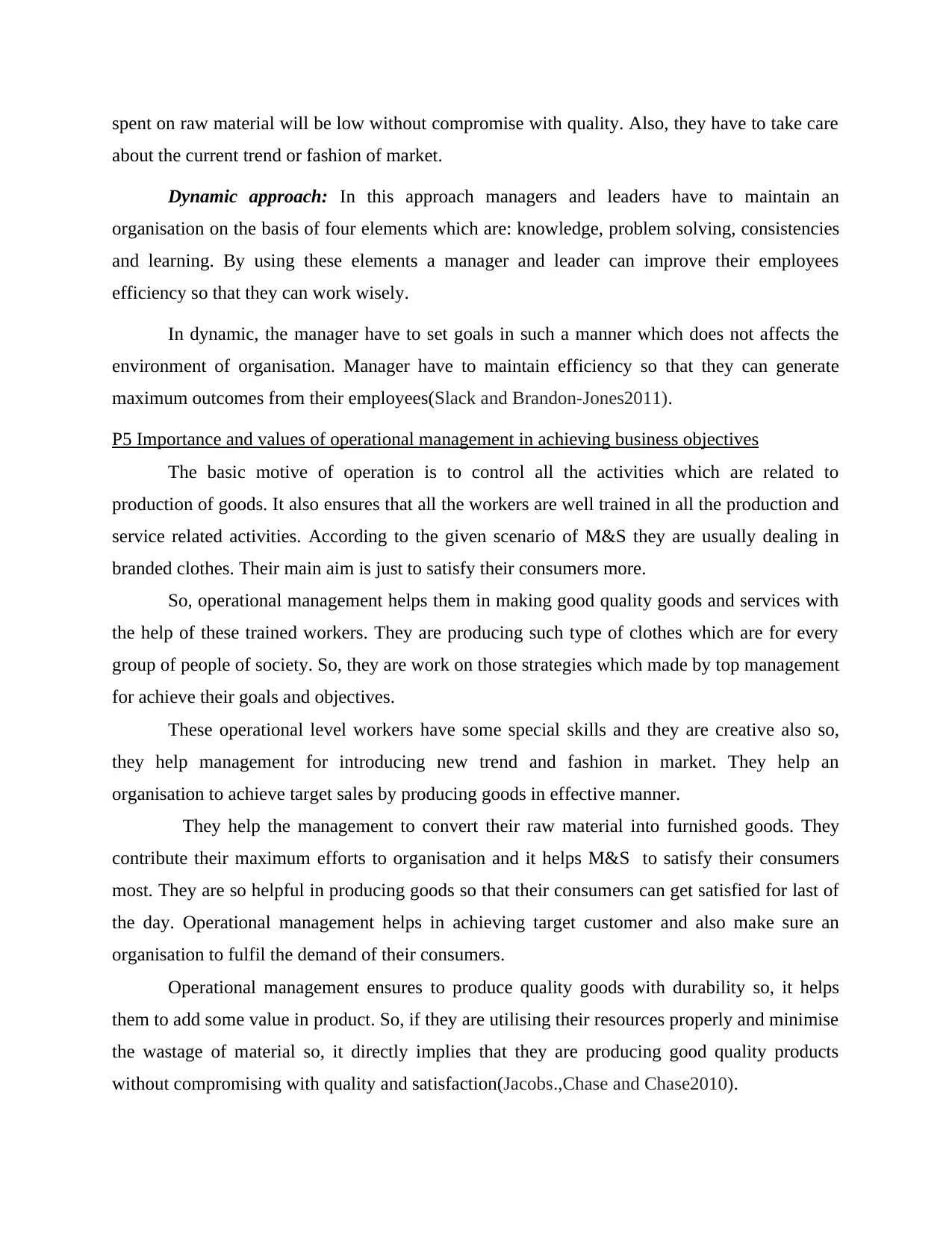
spent on raw material will be low without compromise with quality. Also, they have to take care
about the current trend or fashion of market.
Dynamic approach: In this approach managers and leaders have to maintain an
organisation on the basis of four elements which are: knowledge, problem solving, consistencies
and learning. By using these elements a manager and leader can improve their employees
efficiency so that they can work wisely.
In dynamic, the manager have to set goals in such a manner which does not affects the
environment of organisation. Manager have to maintain efficiency so that they can generate
maximum outcomes from their employees(Slack and Brandon-Jones2011).
P5 Importance and values of operational management in achieving business objectives
The basic motive of operation is to control all the activities which are related to
production of goods. It also ensures that all the workers are well trained in all the production and
service related activities. According to the given scenario of M&S they are usually dealing in
branded clothes. Their main aim is just to satisfy their consumers more.
So, operational management helps them in making good quality goods and services with
the help of these trained workers. They are producing such type of clothes which are for every
group of people of society. So, they are work on those strategies which made by top management
for achieve their goals and objectives.
These operational level workers have some special skills and they are creative also so,
they help management for introducing new trend and fashion in market. They help an
organisation to achieve target sales by producing goods in effective manner.
They help the management to convert their raw material into furnished goods. They
contribute their maximum efforts to organisation and it helps M&S to satisfy their consumers
most. They are so helpful in producing goods so that their consumers can get satisfied for last of
the day. Operational management helps in achieving target customer and also make sure an
organisation to fulfil the demand of their consumers.
Operational management ensures to produce quality goods with durability so, it helps
them to add some value in product. So, if they are utilising their resources properly and minimise
the wastage of material so, it directly implies that they are producing good quality products
without compromising with quality and satisfaction(Jacobs.,Chase and Chase2010).
about the current trend or fashion of market.
Dynamic approach: In this approach managers and leaders have to maintain an
organisation on the basis of four elements which are: knowledge, problem solving, consistencies
and learning. By using these elements a manager and leader can improve their employees
efficiency so that they can work wisely.
In dynamic, the manager have to set goals in such a manner which does not affects the
environment of organisation. Manager have to maintain efficiency so that they can generate
maximum outcomes from their employees(Slack and Brandon-Jones2011).
P5 Importance and values of operational management in achieving business objectives
The basic motive of operation is to control all the activities which are related to
production of goods. It also ensures that all the workers are well trained in all the production and
service related activities. According to the given scenario of M&S they are usually dealing in
branded clothes. Their main aim is just to satisfy their consumers more.
So, operational management helps them in making good quality goods and services with
the help of these trained workers. They are producing such type of clothes which are for every
group of people of society. So, they are work on those strategies which made by top management
for achieve their goals and objectives.
These operational level workers have some special skills and they are creative also so,
they help management for introducing new trend and fashion in market. They help an
organisation to achieve target sales by producing goods in effective manner.
They help the management to convert their raw material into furnished goods. They
contribute their maximum efforts to organisation and it helps M&S to satisfy their consumers
most. They are so helpful in producing goods so that their consumers can get satisfied for last of
the day. Operational management helps in achieving target customer and also make sure an
organisation to fulfil the demand of their consumers.
Operational management ensures to produce quality goods with durability so, it helps
them to add some value in product. So, if they are utilising their resources properly and minimise
the wastage of material so, it directly implies that they are producing good quality products
without compromising with quality and satisfaction(Jacobs.,Chase and Chase2010).
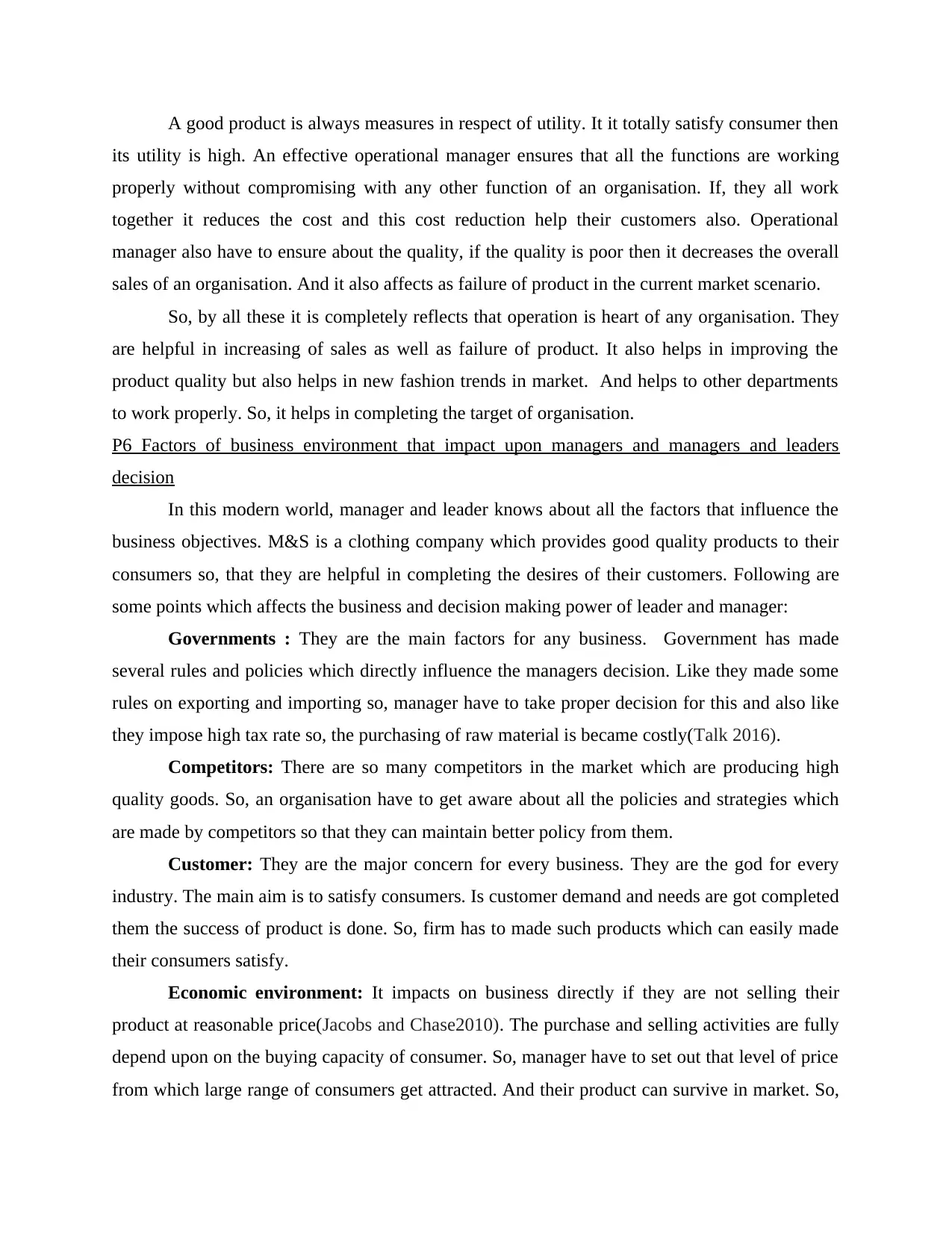
A good product is always measures in respect of utility. It it totally satisfy consumer then
its utility is high. An effective operational manager ensures that all the functions are working
properly without compromising with any other function of an organisation. If, they all work
together it reduces the cost and this cost reduction help their customers also. Operational
manager also have to ensure about the quality, if the quality is poor then it decreases the overall
sales of an organisation. And it also affects as failure of product in the current market scenario.
So, by all these it is completely reflects that operation is heart of any organisation. They
are helpful in increasing of sales as well as failure of product. It also helps in improving the
product quality but also helps in new fashion trends in market. And helps to other departments
to work properly. So, it helps in completing the target of organisation.
P6 Factors of business environment that impact upon managers and managers and leaders
decision
In this modern world, manager and leader knows about all the factors that influence the
business objectives. M&S is a clothing company which provides good quality products to their
consumers so, that they are helpful in completing the desires of their customers. Following are
some points which affects the business and decision making power of leader and manager:
Governments : They are the main factors for any business. Government has made
several rules and policies which directly influence the managers decision. Like they made some
rules on exporting and importing so, manager have to take proper decision for this and also like
they impose high tax rate so, the purchasing of raw material is became costly(Talk 2016).
Competitors: There are so many competitors in the market which are producing high
quality goods. So, an organisation have to get aware about all the policies and strategies which
are made by competitors so that they can maintain better policy from them.
Customer: They are the major concern for every business. They are the god for every
industry. The main aim is to satisfy consumers. Is customer demand and needs are got completed
them the success of product is done. So, firm has to made such products which can easily made
their consumers satisfy.
Economic environment: It impacts on business directly if they are not selling their
product at reasonable price(Jacobs and Chase2010). The purchase and selling activities are fully
depend upon on the buying capacity of consumer. So, manager have to set out that level of price
from which large range of consumers get attracted. And their product can survive in market. So,
its utility is high. An effective operational manager ensures that all the functions are working
properly without compromising with any other function of an organisation. If, they all work
together it reduces the cost and this cost reduction help their customers also. Operational
manager also have to ensure about the quality, if the quality is poor then it decreases the overall
sales of an organisation. And it also affects as failure of product in the current market scenario.
So, by all these it is completely reflects that operation is heart of any organisation. They
are helpful in increasing of sales as well as failure of product. It also helps in improving the
product quality but also helps in new fashion trends in market. And helps to other departments
to work properly. So, it helps in completing the target of organisation.
P6 Factors of business environment that impact upon managers and managers and leaders
decision
In this modern world, manager and leader knows about all the factors that influence the
business objectives. M&S is a clothing company which provides good quality products to their
consumers so, that they are helpful in completing the desires of their customers. Following are
some points which affects the business and decision making power of leader and manager:
Governments : They are the main factors for any business. Government has made
several rules and policies which directly influence the managers decision. Like they made some
rules on exporting and importing so, manager have to take proper decision for this and also like
they impose high tax rate so, the purchasing of raw material is became costly(Talk 2016).
Competitors: There are so many competitors in the market which are producing high
quality goods. So, an organisation have to get aware about all the policies and strategies which
are made by competitors so that they can maintain better policy from them.
Customer: They are the major concern for every business. They are the god for every
industry. The main aim is to satisfy consumers. Is customer demand and needs are got completed
them the success of product is done. So, firm has to made such products which can easily made
their consumers satisfy.
Economic environment: It impacts on business directly if they are not selling their
product at reasonable price(Jacobs and Chase2010). The purchase and selling activities are fully
depend upon on the buying capacity of consumer. So, manager have to set out that level of price
from which large range of consumers get attracted. And their product can survive in market. So,
⊘ This is a preview!⊘
Do you want full access?
Subscribe today to unlock all pages.

Trusted by 1+ million students worldwide
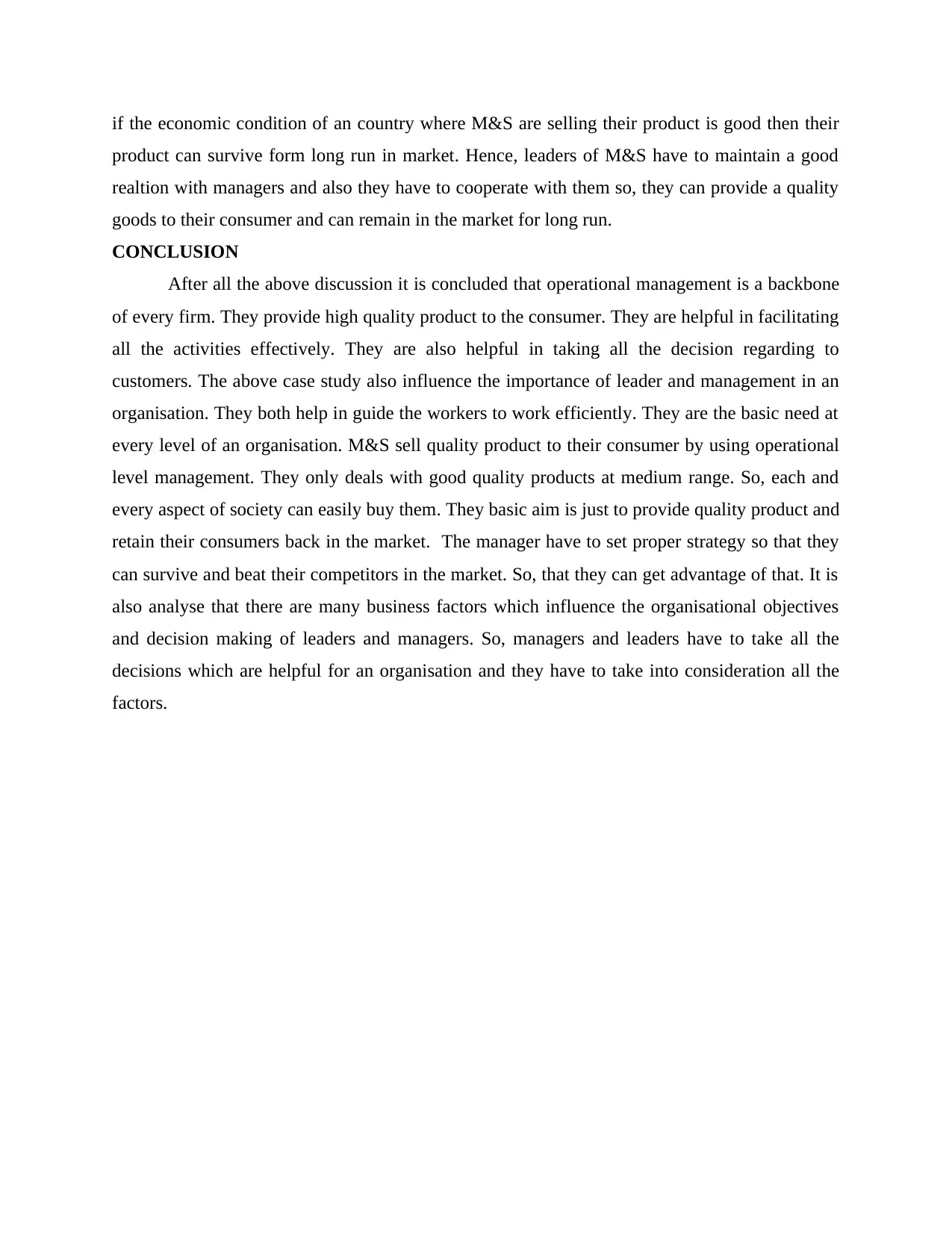
if the economic condition of an country where M&S are selling their product is good then their
product can survive form long run in market. Hence, leaders of M&S have to maintain a good
realtion with managers and also they have to cooperate with them so, they can provide a quality
goods to their consumer and can remain in the market for long run.
CONCLUSION
After all the above discussion it is concluded that operational management is a backbone
of every firm. They provide high quality product to the consumer. They are helpful in facilitating
all the activities effectively. They are also helpful in taking all the decision regarding to
customers. The above case study also influence the importance of leader and management in an
organisation. They both help in guide the workers to work efficiently. They are the basic need at
every level of an organisation. M&S sell quality product to their consumer by using operational
level management. They only deals with good quality products at medium range. So, each and
every aspect of society can easily buy them. They basic aim is just to provide quality product and
retain their consumers back in the market. The manager have to set proper strategy so that they
can survive and beat their competitors in the market. So, that they can get advantage of that. It is
also analyse that there are many business factors which influence the organisational objectives
and decision making of leaders and managers. So, managers and leaders have to take all the
decisions which are helpful for an organisation and they have to take into consideration all the
factors.
product can survive form long run in market. Hence, leaders of M&S have to maintain a good
realtion with managers and also they have to cooperate with them so, they can provide a quality
goods to their consumer and can remain in the market for long run.
CONCLUSION
After all the above discussion it is concluded that operational management is a backbone
of every firm. They provide high quality product to the consumer. They are helpful in facilitating
all the activities effectively. They are also helpful in taking all the decision regarding to
customers. The above case study also influence the importance of leader and management in an
organisation. They both help in guide the workers to work efficiently. They are the basic need at
every level of an organisation. M&S sell quality product to their consumer by using operational
level management. They only deals with good quality products at medium range. So, each and
every aspect of society can easily buy them. They basic aim is just to provide quality product and
retain their consumers back in the market. The manager have to set proper strategy so that they
can survive and beat their competitors in the market. So, that they can get advantage of that. It is
also analyse that there are many business factors which influence the organisational objectives
and decision making of leaders and managers. So, managers and leaders have to take all the
decisions which are helpful for an organisation and they have to take into consideration all the
factors.
Paraphrase This Document
Need a fresh take? Get an instant paraphrase of this document with our AI Paraphraser
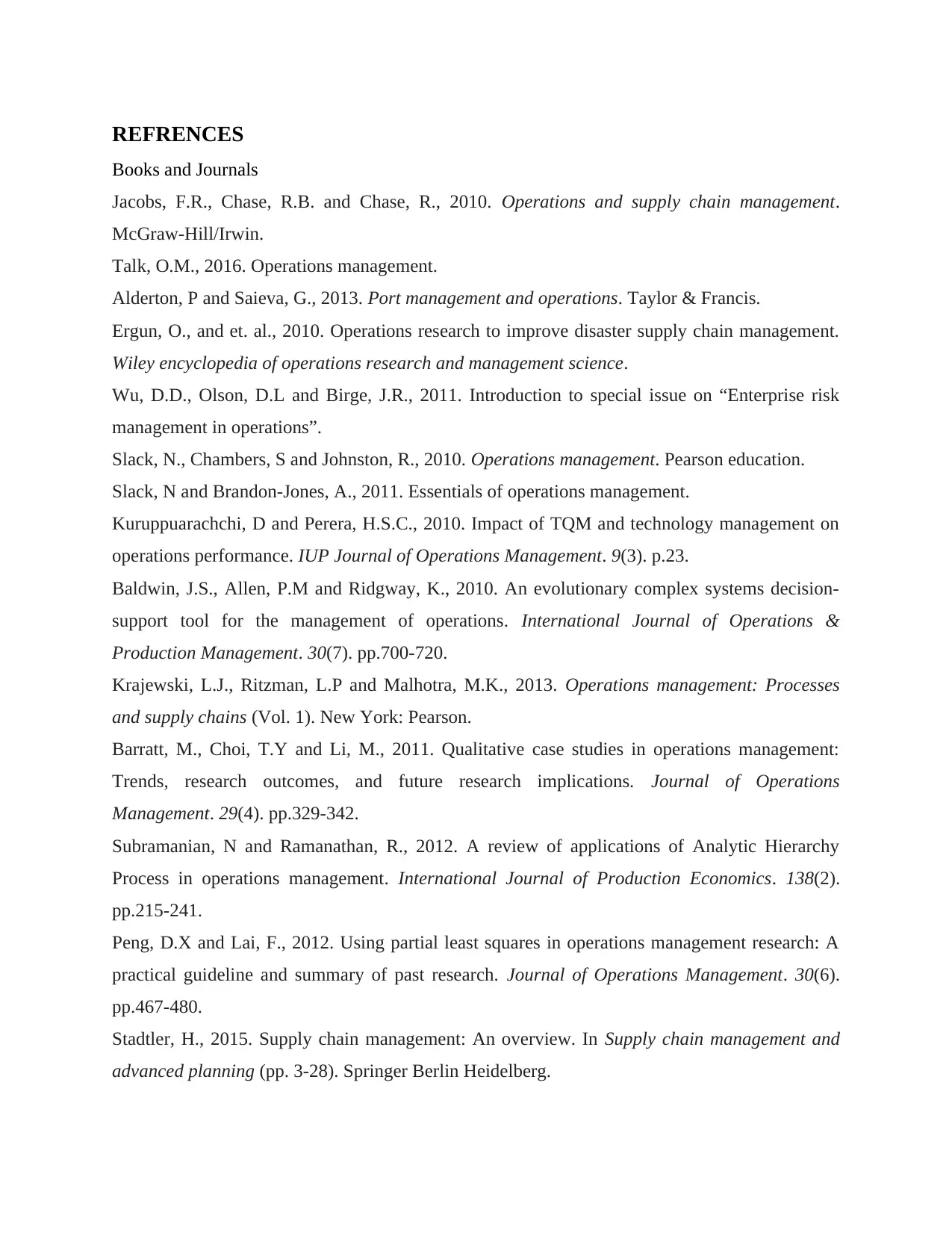
REFRENCES
Books and Journals
Jacobs, F.R., Chase, R.B. and Chase, R., 2010. Operations and supply chain management.
McGraw-Hill/Irwin.
Talk, O.M., 2016. Operations management.
Alderton, P and Saieva, G., 2013. Port management and operations. Taylor & Francis.
Ergun, O., and et. al., 2010. Operations research to improve disaster supply chain management.
Wiley encyclopedia of operations research and management science.
Wu, D.D., Olson, D.L and Birge, J.R., 2011. Introduction to special issue on “Enterprise risk
management in operations”.
Slack, N., Chambers, S and Johnston, R., 2010. Operations management. Pearson education.
Slack, N and Brandon-Jones, A., 2011. Essentials of operations management.
Kuruppuarachchi, D and Perera, H.S.C., 2010. Impact of TQM and technology management on
operations performance. IUP Journal of Operations Management. 9(3). p.23.
Baldwin, J.S., Allen, P.M and Ridgway, K., 2010. An evolutionary complex systems decision-
support tool for the management of operations. International Journal of Operations &
Production Management. 30(7). pp.700-720.
Krajewski, L.J., Ritzman, L.P and Malhotra, M.K., 2013. Operations management: Processes
and supply chains (Vol. 1). New York: Pearson.
Barratt, M., Choi, T.Y and Li, M., 2011. Qualitative case studies in operations management:
Trends, research outcomes, and future research implications. Journal of Operations
Management. 29(4). pp.329-342.
Subramanian, N and Ramanathan, R., 2012. A review of applications of Analytic Hierarchy
Process in operations management. International Journal of Production Economics. 138(2).
pp.215-241.
Peng, D.X and Lai, F., 2012. Using partial least squares in operations management research: A
practical guideline and summary of past research. Journal of Operations Management. 30(6).
pp.467-480.
Stadtler, H., 2015. Supply chain management: An overview. In Supply chain management and
advanced planning (pp. 3-28). Springer Berlin Heidelberg.
Books and Journals
Jacobs, F.R., Chase, R.B. and Chase, R., 2010. Operations and supply chain management.
McGraw-Hill/Irwin.
Talk, O.M., 2016. Operations management.
Alderton, P and Saieva, G., 2013. Port management and operations. Taylor & Francis.
Ergun, O., and et. al., 2010. Operations research to improve disaster supply chain management.
Wiley encyclopedia of operations research and management science.
Wu, D.D., Olson, D.L and Birge, J.R., 2011. Introduction to special issue on “Enterprise risk
management in operations”.
Slack, N., Chambers, S and Johnston, R., 2010. Operations management. Pearson education.
Slack, N and Brandon-Jones, A., 2011. Essentials of operations management.
Kuruppuarachchi, D and Perera, H.S.C., 2010. Impact of TQM and technology management on
operations performance. IUP Journal of Operations Management. 9(3). p.23.
Baldwin, J.S., Allen, P.M and Ridgway, K., 2010. An evolutionary complex systems decision-
support tool for the management of operations. International Journal of Operations &
Production Management. 30(7). pp.700-720.
Krajewski, L.J., Ritzman, L.P and Malhotra, M.K., 2013. Operations management: Processes
and supply chains (Vol. 1). New York: Pearson.
Barratt, M., Choi, T.Y and Li, M., 2011. Qualitative case studies in operations management:
Trends, research outcomes, and future research implications. Journal of Operations
Management. 29(4). pp.329-342.
Subramanian, N and Ramanathan, R., 2012. A review of applications of Analytic Hierarchy
Process in operations management. International Journal of Production Economics. 138(2).
pp.215-241.
Peng, D.X and Lai, F., 2012. Using partial least squares in operations management research: A
practical guideline and summary of past research. Journal of Operations Management. 30(6).
pp.467-480.
Stadtler, H., 2015. Supply chain management: An overview. In Supply chain management and
advanced planning (pp. 3-28). Springer Berlin Heidelberg.
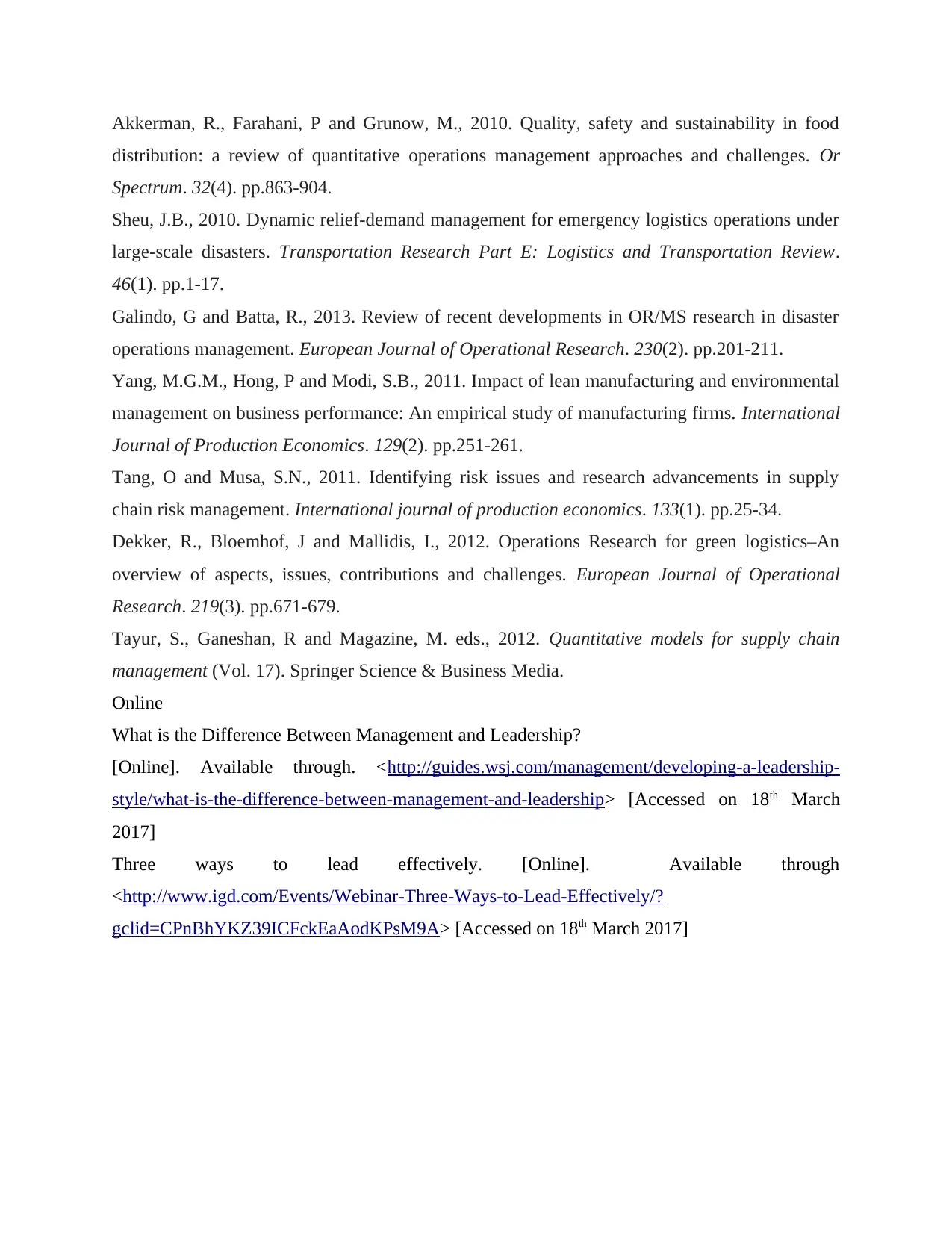
Akkerman, R., Farahani, P and Grunow, M., 2010. Quality, safety and sustainability in food
distribution: a review of quantitative operations management approaches and challenges. Or
Spectrum. 32(4). pp.863-904.
Sheu, J.B., 2010. Dynamic relief-demand management for emergency logistics operations under
large-scale disasters. Transportation Research Part E: Logistics and Transportation Review.
46(1). pp.1-17.
Galindo, G and Batta, R., 2013. Review of recent developments in OR/MS research in disaster
operations management. European Journal of Operational Research. 230(2). pp.201-211.
Yang, M.G.M., Hong, P and Modi, S.B., 2011. Impact of lean manufacturing and environmental
management on business performance: An empirical study of manufacturing firms. International
Journal of Production Economics. 129(2). pp.251-261.
Tang, O and Musa, S.N., 2011. Identifying risk issues and research advancements in supply
chain risk management. International journal of production economics. 133(1). pp.25-34.
Dekker, R., Bloemhof, J and Mallidis, I., 2012. Operations Research for green logistics–An
overview of aspects, issues, contributions and challenges. European Journal of Operational
Research. 219(3). pp.671-679.
Tayur, S., Ganeshan, R and Magazine, M. eds., 2012. Quantitative models for supply chain
management (Vol. 17). Springer Science & Business Media.
Online
What is the Difference Between Management and Leadership?
[Online]. Available through. <http://guides.wsj.com/management/developing-a-leadership-
style/what-is-the-difference-between-management-and-leadership> [Accessed on 18th March
2017]
Three ways to lead effectively. [Online]. Available through
<http://www.igd.com/Events/Webinar-Three-Ways-to-Lead-Effectively/?
gclid=CPnBhYKZ39ICFckEaAodKPsM9A> [Accessed on 18th March 2017]
distribution: a review of quantitative operations management approaches and challenges. Or
Spectrum. 32(4). pp.863-904.
Sheu, J.B., 2010. Dynamic relief-demand management for emergency logistics operations under
large-scale disasters. Transportation Research Part E: Logistics and Transportation Review.
46(1). pp.1-17.
Galindo, G and Batta, R., 2013. Review of recent developments in OR/MS research in disaster
operations management. European Journal of Operational Research. 230(2). pp.201-211.
Yang, M.G.M., Hong, P and Modi, S.B., 2011. Impact of lean manufacturing and environmental
management on business performance: An empirical study of manufacturing firms. International
Journal of Production Economics. 129(2). pp.251-261.
Tang, O and Musa, S.N., 2011. Identifying risk issues and research advancements in supply
chain risk management. International journal of production economics. 133(1). pp.25-34.
Dekker, R., Bloemhof, J and Mallidis, I., 2012. Operations Research for green logistics–An
overview of aspects, issues, contributions and challenges. European Journal of Operational
Research. 219(3). pp.671-679.
Tayur, S., Ganeshan, R and Magazine, M. eds., 2012. Quantitative models for supply chain
management (Vol. 17). Springer Science & Business Media.
Online
What is the Difference Between Management and Leadership?
[Online]. Available through. <http://guides.wsj.com/management/developing-a-leadership-
style/what-is-the-difference-between-management-and-leadership> [Accessed on 18th March
2017]
Three ways to lead effectively. [Online]. Available through
<http://www.igd.com/Events/Webinar-Three-Ways-to-Lead-Effectively/?
gclid=CPnBhYKZ39ICFckEaAodKPsM9A> [Accessed on 18th March 2017]
⊘ This is a preview!⊘
Do you want full access?
Subscribe today to unlock all pages.

Trusted by 1+ million students worldwide
1 out of 12
Related Documents
Your All-in-One AI-Powered Toolkit for Academic Success.
+13062052269
info@desklib.com
Available 24*7 on WhatsApp / Email
![[object Object]](/_next/static/media/star-bottom.7253800d.svg)
Unlock your academic potential
Copyright © 2020–2025 A2Z Services. All Rights Reserved. Developed and managed by ZUCOL.





